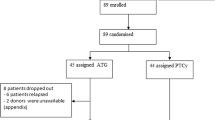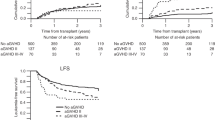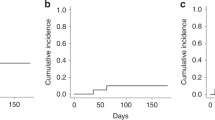Summary:
In all, 41 multiple myeloma (MM) patients received an antithymocyte globulin (ATG), fludarabine, and busulfan-based reduced intensity conditioning (RIC) for allogeneic stem cell transplantation (allo-SCT) from HLA-identical siblings. In total, 29 patients (70%) were in partial remission, one patient in complete remission, and 11 (27%) with progressive disease at the time of allo-SCT. Median time between diagnosis and allo-SCT was 24 months. The cumulative incidences of grade II–IV and grade III–IV acute graft-versus-host disease (GVHD) were 36% (95% CI, 21–51%) and 7% (95% CI, 2–20%), respectively. Overall, 10 patients developed limited chronic GVHD, whereas seven developed an extensive form (cumulative incidence, 41% (95% CI, 26–56%) at 2 years). With a median follow-up of 389 days, the overall cumulative incidence of transplant-related mortality (TRM) was 17% (95% CI, 6–28%). In all, 11 patients (27%) are in continuous complete remission, and the Kaplan–Meier estimates of overall survival (OS) and progression-free survival (PFS) at 2 years were 62% (95% CI, 47–76%) and 41% (95% CI, 23–62%), respectively. PFS and OS were significantly higher in patients with chronic GVHD as compared to patients without chronic GVHD (P=0.006 for PFS and P=0.01 for OS). Collectively, these data demonstrate that RIC allo-SCT can mediate a potentially curative graft-versus-myeloma effect with an acceptable incidence of toxicity and TRM.
This is a preview of subscription content, access via your institution
Access options
Subscribe to this journal
Receive 12 print issues and online access
$259.00 per year
only $21.58 per issue
Buy this article
- Purchase on Springer Link
- Instant access to full article PDF
Prices may be subject to local taxes which are calculated during checkout


Similar content being viewed by others
References
Hahn T, Wingard JR, Anderson KC et al. The role of cytotoxic therapy with hematopoietic stem cell transplantation in the therapy of multiple myeloma: an evidence-based review. Biol Blood Marrow Transplant 2003; 9: 4–37.
Attal M, Harousseau JL, Stoppa AM et al. A prospective, randomized trial of autologous bone marrow transplantation and chemotherapy in multiple myeloma. Intergroupe Francais du Myelome. N Engl J Med 1996; 335: 91–97.
Child JA, Morgan GJ, Davies FE et al. High-dose chemotherapy with hematopoietic stem-cell rescue for multiple myeloma. N Engl J Med 2003; 348: 1875–1883.
Barlogie B, Jagannath S, Vesole DH et al. Superiority of tandem autologous transplantation over standard therapy for previously untreated multiple myeloma. Blood 1997; 89: 789–793.
Gianni AM, Tarella C, Bregni M et al. High-dose sequential chemoradiotherapy, a widely applicable regimen, confers survival benefit to patients with high-risk multiple myeloma. J Clin Oncol 1994; 12: 503–509.
Lenhoff S, Hjorth M, Holmberg E et al. Impact on survival of high-dose therapy with autologous stem cell support in patients younger than 60 years with newly diagnosed multiple myeloma: a population-based study. Nordic Myeloma Study Group. Blood 2000; 95: 7–11.
Palumbo A, Triolo S, Argentino C et al. Dose-intensive melphalan with stem cell support (MEL100) is superior to standard treatment in elderly myeloma patients. Blood 1999; 94: 1248–1253.
Gertz MA, Lacy MQ, Inwards DJ et al. Early harvest and late transplantation as an effective therapeutic strategy in multiple myeloma. Bone Marrow Transplant 1999; 23: 221–226.
Alexanian R, Weber D, Giralt S et al. Impact of complete remission with intensive therapy in patients with responsive multiple myeloma. Bone Marrow Transplant 2001; 27: 1037–1043.
Bensinger WI . Hematopoietic cell transplantation for multiple myeloma. Cancer Control 1998; 5: 235–242.
Weiden PL, Flournoy N, Thomas ED et al. Antileukemic effect of graft-versus-host disease in human recipients of allogeneic-marrow grafts. N Engl J Med 1979; 300: 1068–1073.
Horowitz MM, Gale RP, Sondel PM et al. Graft-versus-leukemia reactions after bone marrow transplantation. Blood 1990; 75: 555–562.
Tricot G, Vesole DH, Jagannath S et al. Graft-versus-myeloma effect: proof of principle. Blood 1996; 87: 1196–1198.
Mehta J, Singhal S . Graft-versus-myeloma. Bone Marrow Transplant 1998; 22: 835–843.
Lokhorst HM, Schattenberg A, Cornelissen JJ et al. Donor lymphocyte infusions for relapsed multiple myeloma after allogeneic stem-cell transplantation: predictive factors for response and long-term outcome. J Clin Oncol 2000; 18: 3031–3037.
Salama M, Nevill T, Marcellus D et al. Donor leukocyte infusions for multiple myeloma. Bone Marrow Transplant 2000; 26: 1179–1184.
Bensinger WI, Buckner CD, Anasetti C et al. Allogeneic marrow transplantation for multiple myeloma: an analysis of risk factors on outcome. Blood 1996; 88: 2787–2793.
Gahrton G, Svensson H, Cavo M et al. Progress in allogenic bone marrow and peripheral blood stem cell transplantation for multiple myeloma: a comparison between transplants performed 1983–93 and 1994–8 at European Group for Blood and Marrow Transplantation centres. Br J Haematol 2001; 113: 209–216.
Mohty M, Bay JO, Faucher C et al. Graft-versus-host disease following allogeneic transplantation from HLA-identical sibling with antithymocyte globulin-based reduced-intensity preparative regimen. Blood 2003; 102: 470–476.
Giralt S, Estey E, Albitar M et al. Engraftment of allogeneic hematopoietic progenitor cells with purine analog-containing chemotherapy: harnessing graft-versus-leukemia without myeloablative therapy. Blood 1997; 89: 4531–4536.
Slavin S, Nagler A, Naparstek E et al. Nonmyeloablative stem cell transplantation and cell therapy as an alternative to conventional bone marrow transplantation with lethal cytoreduction for the treatment of malignant and nonmalignant hematologic diseases. Blood 1998; 91: 756–763.
Khouri IF, Keating M, Korbling M et al. Transplant-lite: induction of graft-versus-malignancy using fludarabine-based nonablative chemotherapy and allogeneic blood progenitor-cell transplantation as treatment for lymphoid malignancies. J Clin Oncol 1998; 16: 2817–2824.
Carella AM, Cavaliere M, Lerma E et al. Autografting followed by nonmyeloablative immunosuppressive chemotherapy and allogeneic peripheral-blood hematopoietic stem-cell transplantation as treatment of resistant Hodgkin's disease and non-Hodgkin's lymphoma. J Clin Oncol 2000; 18: 3918–3924.
Kottaridis PD, Milligan DW, Chopra R et al. In vivo CAMPATH-1 H prevents graft-versus-host disease following nonmyeloablative stem cell transplantation. Blood 2000; 96: 2419–2425.
McSweeney PA, Niederwieser D, Shizuru JA et al. Hematopoietic cell transplantation in older patients with hematologic malignancies: replacing high-dose cytotoxic therapy with graft-versus-tumor effects. Blood 2001; 97: 3390–3400.
Giralt S, Thall PF, Khouri I et al. Melphalan and purine analog-containing preparative regimens: reduced-intensity conditioning for patients with hematologic malignancies undergoing allogeneic progenitor cell transplantation. Blood 2001; 97: 631–637.
Childs R, Chernoff A, Contentin N et al. Regression of metastatic renal-cell carcinoma after nonmyeloablative allogeneic peripheral-blood stem-cell transplantation. N Engl J Med 2000; 343: 750–758.
Badros A, Barlogie B, Siegel E et al. Improved outcome of allogeneic transplantation in high-risk multiple myeloma patients after nonmyeloablative conditioning. J Clin Oncol 2002; 20: 1295–1303.
Badros A, Barlogie B, Morris C et al. High response rate in refractory and poor-risk multiple myeloma after allotransplantation using a nonmyeloablative conditioning regimen and donor lymphocyte infusions. Blood 2001; 97: 2574–2579.
Kroger N, Schwerdtfeger R, Kiehl M et al. Autologous stem cell transplantation followed by a dose-reduced allograft induces high complete remission rate in multiple myeloma. Blood 2002; 100: 755–760.
Maloney DG, Molina AJ, Sahebi F et al. Allografting with non-myeloablative conditioning following cytoreductive autografts for the treatment of patients with multiple myeloma. Blood 2003; First: Edition Paper.
Storb R, Deeg HJ, Whitehead J et al. Methotrexate and cyclosporine compared with cyclosporine alone for prophylaxis of acute graft versus host disease after marrow transplantation for leukemia. N Engl J Med 1986; 314: 729–735.
Przepiorka D, Weisdorf D, Martin P et al. 1994 Consensus Conference on Acute GVHD Grading. Bone Marrow Transplant 1995; 15: 825–828.
Shulman HM, Sullivan KM, Weiden PL et al. Chronic graft-versus-host syndrome in man. A long-term clinicopathologic study of 20 Seattle patients. Am J Med 1980; 69: 204–217.
Farmer ER . The histopathology of graft-versus-host disease. Adv Dermatol 1986; 1: 173–188.
Sullivan KM, Agura E, Anasetti C et al. Chronic graft-versus-host disease and other late complications of bone marrow transplantation. Semin Hematol 1991; 28: 250–259.
Blade J, Samson D, Reece D et al. Criteria for evaluating disease response and progression in patients with multiple myeloma treated by high-dose therapy and haemopoietic stem cell transplantation. Myeloma Subcommittee of the EBMT. European Group for Blood and Marrow Transplant. Br J Haematol 1998; 102: 1115–1123.
Gooley TA, Leisenring W, Crowley J, Storer BE . Estimation of failure probabilities in the presence of competing risks: new representations of old estimators. Stat Med 1999; 18: 695–706.
Kaplan EL, Meier P . Nonparametric estimation from incomplete observations. J Am Stat Assoc 1958; 53: 457–481.
Bjorkstrand BB, Ljungman P, Svensson H et al. Allogeneic bone marrow transplantation versus autologous stem cell transplantation in multiple myeloma: a retrospective case-matched study from the European Group for Blood and Marrow Transplantation. Blood 1996; 88: 4711–4718.
Varterasian M, Janakiraman N, Karanes C et al. Transplantation in patients with multiple myeloma: a multicenter comparative analysis of peripheral blood stem cell and allogeneic transplant. Am J Clin Oncol 1997; 20: 462–466.
Couban S, Stewart AK, Loach D, Panzarella T, Meharchand J . Autologous and allogeneic transplantation for multiple myeloma at a single centre. Bone Marrow Transplant 1997; 19: 783–789.
Bensinger WI . Recent developments in hematopoietic stem cell transplantation for multiple myeloma. Int J Hematol 2003; 77: 232–238.
Lokhorst HM, Segeren CM, Verdonck LF et al. Partially T-cell-depleted allogeneic stem-cell transplantation for first-line treatment of multiple myeloma: a prospective evaluation of patients treated in the phase III study HOVON 24 MM. J Clin Oncol 2003; 21: 1728–1733.
Djulbegovic B, Seidenfeld J, Bonnell C, Kumar A . Nonmyeloablative allogeneic stem-cell transplantation for hematologic malignancies: a systematic review. Cancer Control 2003; 10: 17–41.
Gratwohl A, Baldomero H, Passweg J et al. Hematopoietic stem cell transplantation for hematological malignancies in Europe. Leukemia 2003; 17: 941–959.
Kroger N, Sayer HG, Schwerdtfeger R et al. Unrelated stem cell transplantation in multiple myeloma after a reduced- intensity conditioning with pretransplantation antithymocyte globulin is highly effective with low transplantation-related mortality. Blood 2002; 100: 3919–3924.
Einsele H, Schafer HJ, Hebart H et al. Follow-up of patients with progressive multiple myeloma undergoing allografts after reduced-intensity conditioning. Br J Haematol 2003; 121: 411–418.
Lee CK, Badros A, Barlogie B et al. Prognostic factors in allogeneic transplantation for patients with high-risk multiple myeloma after reduced intensity conditioning. Exp Hematol 2003; 31: 73–80.
Majolino I, Corradini P, Scime R et al. High rate of remission and low rate of disease recurrence in patients with multiple myeloma allografted from their HLA-identical sibling donors. Bone Marrow Transplant 2003; 31: 767–773.
Kroger N, Zabelina T, Kruger W et al. In vivo T cell depletion with pretransplant anti-thymocyte globulin reduces graft-versus-host disease without increasing relapse in good risk myeloid leukemia patients after stem cell transplantation from matched related donors. Bone Marrow Transplant 2002; 29: 683–689.
Orsini E, Bellucci R, Alyea EP et al. Expansion of tumor-specific CD8+ T cell clones in patients with relapsed myeloma after donor lymphocyte infusion. Cancer Res 2003; 63: 2561–2568.
Lim SH, Badros A, Lue C, Barlogie B . Distinct T-cell clonal expansion in the vicinity of tumor cells in plasmacytoma. Cancer 2001; 91: 900–908.
Chiriva-Internati M, Du J, Cannon M, Barlogie B, Yi Q . Myeloma-reactive allospecific cytotoxic T lymphocytes lyse target cells via the granule exocytosis pathway. Br J Haematol 2001; 112: 410–420.
Kolb HJ, Schattenberg A, Goldman JM et al. Graft-versus-leukemia effect of donor lymphocyte transfusions in marrow grafted patients. European Group for Blood and Marrow Transplantation Working Party Chronic Leukemia. Blood 1995; 86: 2041–2050.
Slavin S, Naparstek E, Nagler A et al. Allogeneic cell therapy with donor peripheral blood cells and recombinant human interleukin-2 to treat leukemia relapse after allogeneic bone marrow transplantation. Blood 1996; 87: 2195–2204.
Kersey JH, Weisdorf D, Nesbit ME et al. Comparison of autologous and allogeneic bone marrow transplantation for treatment of high-risk refractory acute lymphoblastic leukemia. N Engl J Med 1987; 317: 461–467.
Sullivan KM, Weiden PL, Storb R et al. Influence of acute and chronic graft-versus-host disease on relapse and survival after bone marrow transplantation from HLA-identical siblings as treatment of acute and chronic leukemia. Blood 1989; 73: 1720–1728.
Gratwohl A, Hermans J, Apperley J et al. Acute graft-versus-host disease: grade and outcome in patients with chronic myelogenous leukemia. Working Party Chronic Leukemia of the European Group for Blood and Marrow Transplantation. Blood 1995; 86: 813–818.
Mohty M, Kuentz M, Michallet M et al. Chronic graft versus host disease after allogeneic blood stem cell transplantation: long term results of a randomized study. Blood 2002; 100: 3128–3134.
Acknowledgements
M Mohty was supported by grants from the ‘Association Méditerranéenne pour le Développement, de la Transplantation’ (Marseille, France) and from the ‘Ligue contre le Cancer du Gard’ (Nimes, France). We thank FB Petersen, MD (University of Utah Health Sciences Center, Salt Lake City, Utah) for critical reading of the manuscript. We thank the nursing staff for providing excellent care for our patients. We also thank the following physicians for their dedicated patient care and important study contributions: N Vey, RT Costello, R Bouabdallah, A Charbonnier, JM Schiano de Collela, C Chabannon, P Ladaique (Institut Paoli-Calmettes); and B Choufi, O Tournilhac (Centre Jean Perrin).
Author information
Authors and Affiliations
Corresponding author
Rights and permissions
About this article
Cite this article
Mohty, M., Boiron, J., Damaj, G. et al. Graft-versus-myeloma effect following antithymocyte globulin-based reduced intensity conditioning allogeneic stem cell transplantation. Bone Marrow Transplant 34, 77–84 (2004). https://doi.org/10.1038/sj.bmt.1704531
Received:
Accepted:
Published:
Issue Date:
DOI: https://doi.org/10.1038/sj.bmt.1704531
Keywords
This article is cited by
-
Adverse impact of high donor CD3+ cell dose on outcome following tandem auto-NMA allogeneic transplantation for high-risk myeloma
Bone Marrow Transplantation (2017)
-
Pushing the envelope—nonmyeloablative and reduced intensity preparative regimens for allogeneic hematopoietic transplantation
Bone Marrow Transplantation (2015)
-
Allo-SCT for multiple myeloma in the era of novel agents: a retrospective study on behalf of Swiss Blood SCT
Bone Marrow Transplantation (2013)
-
Allogeneic Hematopoietic Stem Cell Transplantation for Multiple Myeloma: What Place, If Any?
Current Hematologic Malignancy Reports (2013)
-
The increase from 2.5 to 5 mg/kg of rabbit anti-thymocyte-globulin dose in reduced intensity conditioning reduces acute and chronic GVHD for patients with myeloid malignancies undergoing allo-SCT
Bone Marrow Transplantation (2012)



